
|
Now it is very bright as 8.9 mag (Mar. 15, Chris Wyatt). It is observable at 8 mag for a long time from 2022 to 2023. In the Southern Hemisphere, it stays observable for a long time. In the Northern Hemisphere, it is not observable until summer.
Date(TT) R.A. (2000) Decl. Delta r Elong. m1 Best Time(A, h)
Mar. 18 3 7.45 -47 30.3 2.371 2.116 63 8.3 19:33 ( 37, -9)
Mar. 25 3 26.72 -43 18.4 2.440 2.162 62 8.4 19:39 ( 42, -8)
|

|
It approached to Earth down to 0.29 a.u. in early February, and it brightened up to 4.5 mag (Feb. 1, Juan Jose Gonzalez). Now it is fading. It has already faded down to 9.3 mag (Mar. 16, Chris Wyatt). In the Northern Hemisphere, it stays observable until mid April. In the Southern Hemisphere, it stays observable in good condition after this.
Date(TT) R.A. (2000) Decl. Delta r Elong. m1 Best Time(A, h)
Mar. 18 4 44.29 -4 58.5 1.439 1.507 73 9.6 19:33 ( 49, 37)
Mar. 25 4 48.09 -6 27.6 1.635 1.579 68 10.1 19:39 ( 55, 31)
|

|
Now it is 10.3 mag (Mar. 14, Osamu Miyazaki). It stays bright as 10 mag for a long time until autumn. In the Northern Hemisphere, it becomes unobservable temporarily in early April. But it becomes observable again in summer. In the Southern Hemipshere, it stays unobservable until summer.
Date(TT) R.A. (2000) Decl. Delta r Elong. m1 Best Time(A, h)
Mar. 18 1 59.22 35 56.6 2.848 2.306 48 9.9 19:33 (116, 28)
Mar. 25 2 4.82 33 58.8 2.934 2.286 41 9.9 19:39 (117, 22)
|
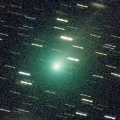
|
It brightened very rapidly. Now it is very bright as 9.3 mag (Mar. 15, Juan Jose Gonzalez). It stays 9-10 mag until March. In the Northern Hemisphere, it stays observable for a long time. But it locates low until spring. In the Southern Hemisphere, it is not observable until June.
Date(TT) R.A. (2000) Decl. Delta r Elong. m1 Best Time(A, h)
Mar. 18 23 19.04 46 49.7 2.267 1.773 48 10.3 4:43 (224, 17)
Mar. 25 23 35.10 45 15.8 2.361 1.793 44 10.4 4:32 (225, 16)
|

|
Now it is 13.2 mag (Mar. 2, Thomas Lehmann). It is expected to brighten up to 10 mag from spring to summer. In the Southern Hemisphere, it stays observable in good condition for a long time. In the Northern Hemisphere, it is not observable until 2024 autumn.
Date(TT) R.A. (2000) Decl. Delta r Elong. m1 Best Time(A, h)
Mar. 18 19 52.66 -40 10.9 3.387 3.115 65 11.1 4:43 (323, 1)
Mar. 25 20 0.83 -42 11.6 3.272 3.105 71 11.0 4:32 (325, 0)
|
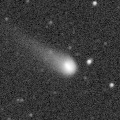
|
Now it is 11.7 mag (Mar. 15, Osamu Miyazaki). It stays 12 mag until summer. It stays observable in good condition for a long time.
Date(TT) R.A. (2000) Decl. Delta r Elong. m1 Best Time(A, h)
Mar. 18 12 21.36 -1 4.5 2.639 3.626 171 11.8 0:43 ( 0, 54)
Mar. 25 12 6.04 -1 21.8 2.628 3.624 178 11.7 23:54 ( 0, 53)
|

|
It brightened up to 8.3 mag in last winter (Jan. 6, 2022, Toshiyuki Takahashi). Now it is fading. But it is bright as 12.0 mag still now (Mar. 16, Chris Wyatt). It is observable in excellent condition in the Southern Hemisphere. It locates low in the Northern Hemisphere.
Date(TT) R.A. (2000) Decl. Delta r Elong. m1 Best Time(A, h)
Mar. 18 9 8.11 -34 34.1 4.527 5.201 128 12.1 21:25 ( 0, 20)
Mar. 25 9 5.40 -34 9.6 4.603 5.243 125 12.2 20:55 ( 0, 21)
|

|
Now it is 12.0 mag (Feb. 27, Osamu Miyazaki). It stays 12 mag until spring.
Date(TT) R.A. (2000) Decl. Delta r Elong. m1 Best Time(A, h)
Mar. 18 17 23.12 -19 3.8 1.448 1.834 95 12.2 4:43 (343, 34)
Mar. 25 17 32.33 -19 1.0 1.410 1.867 100 12.3 4:32 (345, 35)
|
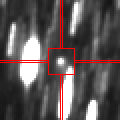
|
Now it is 13.7 mag (Feb. 26, F. Kugel, J. Nicolas). It will brighten very rapidly. It is expected to be observable at 11 mag in excellent condition from spring to summer.
Date(TT) R.A. (2000) Decl. Delta r Elong. m1 Best Time(A, h)
Mar. 18 18 23.99 -22 58.5 1.938 2.040 81 12.7 4:43 (329, 25)
Mar. 25 18 37.80 -22 2.7 1.855 2.028 85 12.4 4:32 (329, 26)
|

|
Now it is bright as 12.5 mag (Mar. 1, Giuseppe Pappa). It stays 13 mag until spring. It stays observable in good condition for a while after this.
Date(TT) R.A. (2000) Decl. Delta r Elong. m1 Best Time(A, h)
Mar. 18 15 44.77 10 15.8 4.253 4.836 120 13.0 4:05 ( 0, 65)
Mar. 25 15 44.59 11 36.6 4.209 4.863 126 13.0 3:37 ( 0, 66)
|
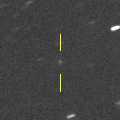
|
Now it is 12.8 mag (Mar. 8, Taras Prystavski). The condition is bad in this apparition. Appearing in the morning sky in the Southern Hemisphere. It is not observable until May in the Northern Hemisphere.
Date(TT) R.A. (2000) Decl. Delta r Elong. m1 Best Time(A, h)
Mar. 18 21 39.54 -20 8.6 2.359 1.670 36 13.2 4:43 (293, -3)
Mar. 25 21 58.72 -18 51.6 2.347 1.691 38 13.2 4:32 (291, -3)
|
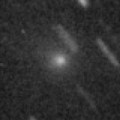
|
Bright new comet. Now it is 13.2 mag (Mar. 2, Giuseppe Pappa). In the Southern Hemisphere, it stays observable in good condition after this. In the Northern Hemisphere, it is not observable after this.
Date(TT) R.A. (2000) Decl. Delta r Elong. m1 Best Time(A, h)
Mar. 18 21 18.44 -38 49.7 1.747 1.358 50 13.5 4:43 (310,-10)
Mar. 25 21 39.66 -43 19.0 1.724 1.440 56 13.8 4:32 (313,-14)
|

|
It brightened up to 14.5 mag in February (Feb. 16, Ken-ichi Kadota). It is expected to brighten up to 8 mag in July. Now it is not observable. In the Southern Hemisphere, it will appear in the morning sky at 13 mag in mid April, and it will be observable in excellent condition at the high light. In the Northern Hemisphere, it is not observable until June, and it becomes very low at the high lihght.
Date(TT) R.A. (2000) Decl. Delta r Elong. m1 Best Time(A, h)
Mar. 18 0 26.75 -11 22.0 3.303 2.349 13 13.8 19:33 ( 88,-16)
Mar. 25 0 28.74 -11 8.4 3.241 2.282 13 13.6 19:39 ( 92,-23)
|

|
Now it is 14.6 mag (Mar. 16, Chris Wyatt). The brightness evolution is slower than originally predicted. It stays 14 mag until summer. In the Northern Hemisphere, it will too low to observe in late March. In the Southern Hemisphere, it stays observable in good condition for a long time.
Date(TT) R.A. (2000) Decl. Delta r Elong. m1 Best Time(A, h)
Mar. 18 3 39.52 -18 26.0 2.427 2.099 59 13.7 19:33 ( 53, 16)
Mar. 25 3 47.28 -19 14.4 2.460 2.080 56 13.7 19:39 ( 57, 11)
|

|
Now it is 14 mag (Mar. 5, Giuseppe Pappa).
Date(TT) R.A. (2000) Decl. Delta r Elong. m1 Best Time(A, h)
Mar. 18 6 18.08 28 6.6 5.876 6.081 97 13.7 19:33 ( 64, 76)
Mar. 25 6 19.71 27 56.6 5.991 6.083 90 13.8 19:39 ( 76, 70)
|

|
It brightened very rapidly up to 9.6 mag in late January (Jan. 25, Toshihiko Ikemura, Hirohisa Sato). Now it is fading. It has already faded down to 12.8 mag (Mar. 3, Ken-ichi Kadota). It stays observable in good condition for a long time.
Date(TT) R.A. (2000) Decl. Delta r Elong. m1 Best Time(A, h)
Mar. 18 6 30.40 3 45.4 1.098 1.612 100 13.9 19:33 ( 20, 57)
Mar. 25 6 42.18 0 41.3 1.222 1.669 97 14.5 19:39 ( 28, 52)
|
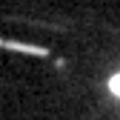
|
Now it is 14.9 mag (Mar. 15, Chris Wyatt). It will brighten rapidly up to 14 mag and will be observable in excellent condition in spring. In the Northern Hemisphere, it was observable in good condition in winter, but it becomes somewhat low in spring.
Date(TT) R.A. (2000) Decl. Delta r Elong. m1 Best Time(A, h)
Mar. 18 14 34.05 -22 40.3 1.556 2.351 133 14.2 2:55 ( 0, 32)
Mar. 25 14 30.82 -24 12.7 1.498 2.350 139 14.2 2:24 ( 0, 31)
|
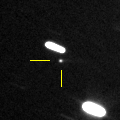
|
Now it is 15.6 mag (Mar. 13, ATLAS South Africa). It will brighten very rapidly up to 11.5 mag in April. In the Southern Hemisphere, it stays observable in good condition for a long time. In the Northern Hemisphere, it is not observable from mid April to mid June.
Date(TT) R.A. (2000) Decl. Delta r Elong. m1 Best Time(A, h)
Mar. 18 14 40.95 28 4.1 0.269 1.188 130 15.5 3:00 ( 0, 83)
Mar. 25 15 32.59 30 52.2 0.199 1.117 122 14.2 3:23 ( 0, 86)
|
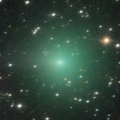
|
It brightened up to 9.7 mag in autumn (Oct. 23, Marco Goiato). Now it is fading. It has already faded down to 12.9 mag (Mar. 14, Thomas Lehmann). In the Southern Hemisphere, it stays observable in good condition for a long time. It locates low in the Northern Hemisphere.
Date(TT) R.A. (2000) Decl. Delta r Elong. m1 Best Time(A, h)
Mar. 18 18 53.27 -42 3.6 2.097 2.111 77 14.3 4:43 (333, 6)
Mar. 25 18 39.69 -43 1.6 1.989 2.167 86 14.6 4:32 (338, 7)
|
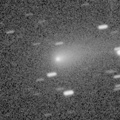
|
Now it is 13.8 mag (Mar. 11, Thomas Lehmann). It will be fading after this. It stays observable in good condition for a while.
Date(TT) R.A. (2000) Decl. Delta r Elong. m1 Best Time(A, h)
Mar. 18 8 29.84 20 27.6 1.294 2.061 127 14.4 20:48 ( 0, 75)
Mar. 25 8 34.92 20 47.8 1.380 2.087 122 14.7 20:25 ( 0, 76)
|
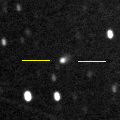
|
Now it is 14.7 mag (Mar. 16, Chris Wyatt). It is expected to brighten up to 7 mag in early 2024. In the Southern Hemisphere, it stays observable in good condition for a long time. It locates low in the Northern Hemisphere.
Date(TT) R.A. (2000) Decl. Delta r Elong. m1 Best Time(A, h)
Mar. 18 5 15.53 -31 47.5 4.372 4.353 82 14.6 19:33 ( 26, 18)
Mar. 25 5 17.97 -30 49.9 4.365 4.285 78 14.5 19:39 ( 33, 15)
|
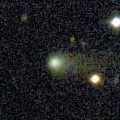
|
Now it is 15.0 mag (Mar. 2, ATLAS Chile). It stays 14.5 mag and observable in good condition until spring.
Date(TT) R.A. (2000) Decl. Delta r Elong. m1 Best Time(A, h)
Mar. 18 9 21.06 29 2.3 2.607 3.387 135 14.6 21:39 ( 0, 84)
Mar. 25 9 21.62 29 17.5 2.681 3.395 128 14.7 21:12 ( 0, 84)
|

|
Now it is 15.3 mag (Mar. 11, Thomas Lehmann). It stays 14 mag in 2023. In the Southern Hemisphere, it stays observable in good condition for a long time, although it becomes unobservable temporarily from April to May. It locates somewhat low in the Northern Hemisphere.
Date(TT) R.A. (2000) Decl. Delta r Elong. m1 Best Time(A, h)
Mar. 18 2 33.85 -6 55.8 3.980 3.303 41 14.7 19:33 ( 73, 12)
Mar. 25 2 33.64 -5 45.1 4.049 3.290 35 14.7 19:39 ( 79, 6)
|

|
It approached to Sun down to 0.1 a.u. on Jan. 31. It was bright as 7.0-7.5 mag in early February (Feb. 5, Michael Jager). Now it is fading rapidly. It has already faded down to 12.0 mag (Mar. 6, Ken-ichi Kadota). It stays observable after this while the comet will be fading.
Date(TT) R.A. (2000) Decl. Delta r Elong. m1 Best Time(A, h)
Mar. 18 20 18.99 -7 48.8 1.555 1.235 52 14.8 4:43 (295, 20)
Mar. 25 20 20.13 -8 6.5 1.571 1.360 59 15.3 4:32 (298, 23)
|
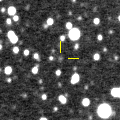
|
Now it is 15.3 mag (Mar. 12, ATLAS Chile). It will brighten up to 13 mag from 2024 to 2025. It is observable in excllent condition in the Southern Hemisphere. It locates low in the Northern Hemisphere.
Date(TT) R.A. (2000) Decl. Delta r Elong. m1 Best Time(A, h)
Mar. 18 8 45.15 -36 58.9 5.838 6.434 122 15.2 21:02 ( 0, 18)
Mar. 25 8 44.16 -36 15.7 5.838 6.402 120 15.2 20:34 ( 0, 19)
|

|
Now it is 15.2 mag (Mar. 1, ATLAS South Africa). It is expected to brighten up to 12 mag from 2024 to 2025.
Date(TT) R.A. (2000) Decl. Delta r Elong. m1 Best Time(A, h)
Mar. 18 9 20.73 -12 27.3 5.122 5.927 140 15.4 21:38 ( 0, 43)
Mar. 25 9 15.35 -11 14.8 5.140 5.884 134 15.4 21:05 ( 0, 44)
|

|
It brightened up to 13.4 mag in last summer (July 7, Giuseppe Pappa). Now it is fading. It has already faded down to 15.5 mag (Mar. 3, Ken-ichi Kadota). It stays 15-16 mag until summer. It stays observable in good condition for a while.
Date(TT) R.A. (2000) Decl. Delta r Elong. m1 Best Time(A, h)
Mar. 18 18 7.97 6 36.2 3.399 3.462 85 15.4 4:43 (313, 53)
Mar. 25 18 5.69 9 1.2 3.322 3.498 91 15.4 4:32 (318, 57)
|

|
Now it is 14.8 mag (Dec. 8, ATLAS Chile). In the Southern Hemisphere, apperaing in the morning sky. In the Northern Hemisphere, it will become observable in late May.
Date(TT) R.A. (2000) Decl. Delta r Elong. m1 Best Time(A, h)
Mar. 18 22 47.88 -14 58.5 4.194 3.279 20 15.4 4:43 (279,-13)
Mar. 25 22 57.54 -14 3.6 4.172 3.291 24 15.4 4:32 (279,-11)
|

|
It continued brightening even after the perihelion passage. Now it is 15.4 mag (Mar. 5, Giuseppe Pappa). It will be fading after this, and it will be fainter than 18 mag in July. It is observable in good condition in the Northern Hemisphere. It locates somewhat low in the Southern Hemisphere.
Date(TT) R.A. (2000) Decl. Delta r Elong. m1 Best Time(A, h)
Mar. 18 7 31.05 25 48.3 2.199 2.752 113 15.5 19:49 ( 0, 81)
Mar. 25 7 35.18 25 43.8 2.307 2.776 107 15.7 19:39 ( 18, 80)
|

|
Now it is 17.6 mag (Mar. 12, B. Lutkenhoner, N. Paul, E. Cortes). It will approach to Sun down to 0.8 a.u. in April, and it will brighten up to 15 mag. In the Southern Hemisphere, it stays observable in the extremely low sky. In the Northern Hemisphere, it is not observable after March.
Date(TT) R.A. (2000) Decl. Delta r Elong. m1 Best Time(A, h)
Mar. 18 21 32.14 -14 54.7 1.499 0.912 36 16.0 4:43 (290, 2)
Mar. 25 22 9.54 -12 16.5 1.504 0.874 33 15.5 4:32 (284, -1)
|

|
Now it is 16.4 mag (Mar. 13, ATLAS South Africa). It is expected to brighten up to 11.5 mag in 2024 spring. It stays observable in good condition for a long time. At the high light, it will be observable in excellent condition in the Southern Hemisphere, but it will be low in the Northern Hemisphere.
Date(TT) R.A. (2000) Decl. Delta r Elong. m1 Best Time(A, h)
Mar. 18 18 36.84 17 9.3 4.560 4.474 78 15.8 4:43 (292, 55)
Mar. 25 18 35.51 17 47.6 4.408 4.423 84 15.7 4:32 (296, 59)
|

|
It brightened up to 9.3 mag in early summer in 2022 (June 5, Chris Wyatt). Now it is fading. It has already faded down to 16.4 mag (Mar. 12, ATLAS Chile). In the Southen Hemisphere, it stays observable in good condition for a long time. It locates somewhat low in the Northern Hemisphere.
Date(TT) R.A. (2000) Decl. Delta r Elong. m1 Best Time(A, h)
Mar. 18 6 42.46 -16 18.7 3.386 3.732 102 15.9 19:33 ( 10, 38)
Mar. 25 6 41.32 -14 4.9 3.543 3.796 97 16.1 19:39 ( 21, 38)
|

|
Now it is 16.1 mag (Mar. 9, B. Lutkenhoner, N. Paul, E. Cortes). It will brighten rapidly up to 13.5 mag in summer. In the Southern Hemisphere, it stays observable until August. In the Northern Hemisphere, it is not observable until June. But it stays observable in good condition after that.
Date(TT) R.A. (2000) Decl. Delta r Elong. m1 Best Time(A, h)
Mar. 18 22 43.12 -38 2.2 2.738 2.072 39 16.1 4:43 (301,-24)
Mar. 25 22 59.30 -35 34.5 2.678 2.032 40 16.0 4:32 (298,-23)
|
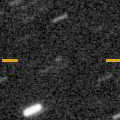
|
Now it is 17.3 mag (Mar. 8, J.-C. Merlin). It stays observable at 14-15 mag from spring to autumn. It locates somewhat low in the Northern Hemisphere.
Date(TT) R.A. (2000) Decl. Delta r Elong. m1 Best Time(A, h)
Mar. 18 18 6.42 -14 14.3 2.999 3.081 85 16.1 4:43 (329, 35)
Mar. 25 18 12.95 -14 33.2 2.889 3.066 90 16.0 4:32 (332, 36)
|
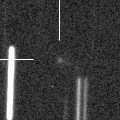
|
Now it is 16.5 mag (Feb. 23, Ken-ichi Kadota). It will brighten up to 13 mag in summer. In the Northern Hemisphere, it stays observable in good condition for a long time. In the Southern Hemisphere, it is not observable until August.
Date(TT) R.A. (2000) Decl. Delta r Elong. m1 Best Time(A, h)
Mar. 18 2 41.42 71 34.7 1.897 1.949 77 16.3 19:33 (157, 40)
Mar. 25 2 29.29 69 28.8 1.945 1.885 71 16.2 19:39 (155, 36)
|
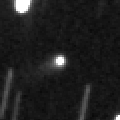
|
Now it is 15.7 mag (Mar. 5, Giuseppe Pappa). It stays observable at 16 mag for a long time from early 2023 to early 2024. In the Northern Hemisphere, it is observable only until 2023 spring.
Date(TT) R.A. (2000) Decl. Delta r Elong. m1 Best Time(A, h)
Mar. 18 8 47.56 -6 53.3 3.328 4.085 134 16.2 21:04 ( 0, 48)
Mar. 25 8 40.41 -7 12.4 3.386 4.059 126 16.2 20:30 ( 0, 48)
|

|
It was observed at 15 mag from 2021 to 2022. Now it is fading. Now it is 16.3 mag (Feb. 11, J.-C. Merlin, D. De Martin). In the Southern Hemisphere, it stays observable in excellent condition for a long time. In the Northern Hemiphere, it is not observable after this.
Date(TT) R.A. (2000) Decl. Delta r Elong. m1 Best Time(A, h)
Mar. 18 14 22.90 -72 21.4 5.966 6.256 102 16.3 2:45 ( 0,-17)
Mar. 25 14 4.28 -73 6.0 5.932 6.287 106 16.4 1:59 ( 0,-18)
|
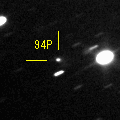
|
Now it is 16.6 mag (Mar. 6, Ken-ichi Kadota). It is observable at 16.5 mag in good condition in spring. It locates somewhat low in the Southern Hemisphere.
Date(TT) R.A. (2000) Decl. Delta r Elong. m1 Best Time(A, h)
Mar. 18 8 14.53 28 28.2 1.578 2.271 122 16.5 20:33 ( 0, 83)
Mar. 25 8 17.54 28 4.8 1.638 2.262 116 16.5 20:08 ( 0, 83)
|
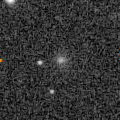
|
Now it is 16.9 mag (Mar. 2, ATLAS Chile). It moves along an almost circular orbit. It seems to be bright temporarily in outburst.
Date(TT) R.A. (2000) Decl. Delta r Elong. m1 Best Time(A, h)
Mar. 18 10 45.54 26 2.0 5.252 6.142 150 16.5 23:03 ( 0, 81)
Mar. 25 10 42.80 26 9.3 5.301 6.141 144 16.5 22:32 ( 0, 81)
|
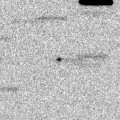
|
Now it is 16.4 mag (Mar. 1, Catalina Sky Survey). It is observable at 16.5 mag in good condition from January to March. It locates somewhat low in the Southern Hemisphere.
Date(TT) R.A. (2000) Decl. Delta r Elong. m1 Best Time(A, h)
Mar. 18 13 37.01 30 56.4 0.425 1.351 140 16.6 1:58 ( 0, 86)
Mar. 25 13 35.24 30 14.0 0.453 1.386 142 16.7 1:28 ( 0, 85)
|

|
Now it is 15.8 mag (Feb. 22, ATLAS South Africa). It was expected to brighten up to 13 mag in 2022 spring. But actually, it was fainter than originally expected. In the Southern Hemisphere, it stays observable in good condition for a long time, although it becomes unobservable temporarily from April to May. In the Northern Hemisphere, it is not observable until July.
Date(TT) R.A. (2000) Decl. Delta r Elong. m1 Best Time(A, h)
Mar. 18 2 21.34 -17 50.2 4.759 4.062 41 16.6 19:33 ( 66, 3)
Mar. 25 2 24.19 -16 20.5 4.857 4.102 36 16.7 19:39 ( 72, -2)
|
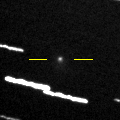
|
Now it is 16.0 mag (Mar. 10, Catalina Sky Survey). In the Northern Hemisphere, it stays observable at 16.5 mag in excellent condition from February to March. It locates low in the Southern Hemisphere.
Date(TT) R.A. (2000) Decl. Delta r Elong. m1 Best Time(A, h)
Mar. 18 7 39.25 53 10.4 1.274 1.835 107 16.7 19:56 (180, 72)
Mar. 25 7 25.23 45 46.4 1.360 1.837 101 16.8 19:39 (158, 79)
|
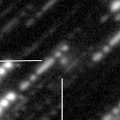
|
Now it is 16.2 mag (Mar. 12, ATLAS South Africa). It brightens up to 16.5 mag from March to April. In the Southern Hemisphere, it stays observable in excellent condition. In the Northern Hemisphere, it will be getting higher gradually after this.
Date(TT) R.A. (2000) Decl. Delta r Elong. m1 Best Time(A, h)
Mar. 18 11 45.00 -51 40.5 0.955 1.745 127 16.8 0:06 ( 0, 3)
Mar. 25 11 51.25 -48 25.9 0.915 1.753 132 16.7 23:41 ( 0, 7)
|

|
It brightened up to 12.7 mag in last year (Feb. 27, 2022, Jose Guilherme de S. Aguiar). Now it is fading. Appearing in the morning sky. In the Southern Hemisphere, it stays observable until summer when it becomes fainter than 18 mag. It locates low in the Northern Hemisphere.
Date(TT) R.A. (2000) Decl. Delta r Elong. m1 Best Time(A, h)
Mar. 18 19 20.18 -25 17.3 2.930 2.732 68 16.7 4:43 (319, 17)
Mar. 25 19 29.25 -25 7.5 2.866 2.757 73 16.8 4:32 (320, 18)
|

|
Now it is 16.9 mag (Mar. 13, ATLAS Chile). Very far object. It stays 16-17 mag for a long time from 2021 to 2026. In the Southern Hemisphere, it stays observable in good condition for a long time. In the Northern Hemisphere, it is not observable at all.
Date(TT) R.A. (2000) Decl. Delta r Elong. m1 Best Time(A, h)
Mar. 18 4 58.07 -71 56.0 10.435 10.394 84 16.8 19:33 ( 11,-20)
Mar. 25 4 56.39 -71 16.8 10.423 10.390 85 16.8 19:39 ( 14,-21)
|

|
Now it is 17.6 mag (Mar. 10, A. Diepvens). It will brighten up to 13 mag from June to August. In the Northern Hemisphere, it stays observable in excellent condition. In the Southern Hemisphere, it becomes unobservable from late April to early August.
Date(TT) R.A. (2000) Decl. Delta r Elong. m1 Best Time(A, h)
Mar. 18 12 48.74 20 27.2 0.955 1.907 155 17.2 1:10 ( 0, 75)
Mar. 25 12 45.81 25 48.6 0.886 1.826 151 16.9 0:39 ( 0, 80)
|
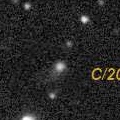
|
Now it is 16.8 mag (Mar. 12, ATLAS South Africa). It stays 17 mag and observable in good condition until summer.
Date(TT) R.A. (2000) Decl. Delta r Elong. m1 Best Time(A, h)
Mar. 18 13 8.12 10 10.7 8.000 8.932 158 17.0 1:29 ( 0, 65)
Mar. 25 13 3.62 10 46.3 7.982 8.938 162 17.0 0:57 ( 0, 66)
|

|
It has not been observed yet in this apparition. In the last apparition, it had faded before the perihelion passage. If it becomes as bright as its last apparition, it will brighten up to 17 mag. It stays observable in good condition for a long time.
Date(TT) R.A. (2000) Decl. Delta r Elong. m1 Best Time(A, h)
Mar. 18 14 15.93 3 11.1 1.944 2.804 143 17.1 2:36 ( 0, 58)
Mar. 25 14 14.64 3 57.6 1.884 2.788 149 17.0 2:08 ( 0, 59)
|
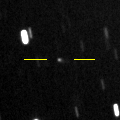
|
Now it is 17.5 mag (Mar. 12, ATLAS-HKO, Haleakala). In the Northern Hemisphere, it stays observable at 17 mag in good condition from spring to summer. In the Southern Hemisphere, it locates extremely low only in summer.
Date(TT) R.A. (2000) Decl. Delta r Elong. m1 Best Time(A, h)
Mar. 18 13 16.53 51 19.6 2.519 3.214 126 17.1 1:37 (180, 74)
Mar. 25 13 14.82 52 52.2 2.516 3.184 124 17.0 1:08 (180, 72)
|
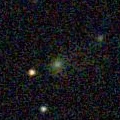
|
It brightened rapidly. Now it is 16.2 mag (Feb. 27, Masayoshi Yoshimi). It will be fading after this. It will be fainter than 18 mag in April.
Date(TT) R.A. (2000) Decl. Delta r Elong. m1 Best Time(A, h)
Mar. 18 9 52.80 22 10.4 1.218 2.112 144 17.1 22:10 ( 0, 77)
Mar. 25 9 52.76 22 5.5 1.291 2.141 138 17.4 21:43 ( 0, 77)
|
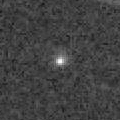
|
It was observed at 17 mag in 2022 autumn. It is observable at 17 mag also in 2023 spring.
Date(TT) R.A. (2000) Decl. Delta r Elong. m1 Best Time(A, h)
Mar. 18 20 28.75 2 41.9 2.211 1.747 50 17.1 4:43 (285, 25)
Mar. 25 20 22.78 4 27.8 2.099 1.779 57 17.1 4:32 (287, 30)
|
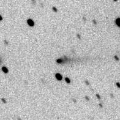
|
Now it is 16.8 mag (Mar. 2, ATLAS Chile). It will be fading and getting lower gradually after this. It will be unobservable in April in the Northern Hemisphere, or in May in the Southern Hemisphere.
Date(TT) R.A. (2000) Decl. Delta r Elong. m1 Best Time(A, h)
Mar. 18 4 30.88 4 4.9 3.755 3.554 70 17.1 19:33 ( 60, 41)
Mar. 25 4 37.51 4 39.4 3.851 3.561 65 17.2 19:39 ( 67, 37)
|
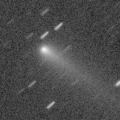
|
It brightened up to 14.1 mag in autumn (Nov. 14, Thomas Lehmann). Now it is fading. It has already faded down to 16.8 mag (Feb. 27, Masayoshi Yoshimi). In the Northern Hemisphere, it stays observable in excellent condition for a while. In the Southern Hemisphere, it will be unobservable soon.
Date(TT) R.A. (2000) Decl. Delta r Elong. m1 Best Time(A, h)
Mar. 18 3 39.46 35 32.5 2.964 2.701 65 17.2 19:33 (107, 47)
Mar. 25 3 52.46 36 9.3 3.064 2.727 61 17.3 19:39 (110, 43)
|
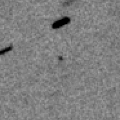
|
Now it is 17.5 mag (Mar. 10, A. Diepvens). It stays observable at 17 mag from spring to early summer. It locates low in the Southern Hemisphere.
Date(TT) R.A. (2000) Decl. Delta r Elong. m1 Best Time(A, h)
Mar. 18 9 9.58 38 14.0 1.874 2.609 128 17.2 21:27 (180, 87)
Mar. 25 9 8.98 37 54.6 1.927 2.597 121 17.2 20:59 (180, 87)
|

|
It brightened very rapidly up to 15.5 mag from last autumn to last winter (Nov. 2, 2021, Toshihiko Ikemura, Hirohisa Sato). Now it is fading slowly. It has already faded down to 17.9 mag (Mar. 9, ATLAS South Africa).
Date(TT) R.A. (2000) Decl. Delta r Elong. m1 Best Time(A, h)
Mar. 18 6 14.60 10 59.4 4.480 4.702 96 17.3 19:33 ( 33, 62)
Mar. 25 6 17.34 11 11.3 4.607 4.723 90 17.4 19:39 ( 47, 58)
|
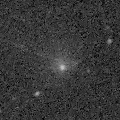
|
Now it is 17.1 mag (Mar. 13, ATLAS Chile). Very large comet. It is expected to brighten up to 14 mag in 2031. In the Southern Hemisphere, it stays observable in good condition for a long time. In the Northern Hemisphere, it is not observable until 2030.
Date(TT) R.A. (2000) Decl. Delta r Elong. m1 Best Time(A, h)
Mar. 18 2 37.10 -57 56.1 18.263 17.876 65 17.3 19:33 ( 32,-19)
Mar. 25 2 39.49 -57 44.6 18.234 17.851 65 17.3 19:39 ( 35,-23)
|
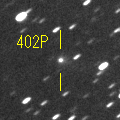
|
It brightened up to 15.3 mag in last winter (Jan. 12, 2022, H. Nohara). Now it is fading. It has already faded down to 17.4 mag (Mar. 11, A. Diepvens). It will be observable at 17 mag in good condition in next winter. It locates low in the Southern Hemisphere.
Date(TT) R.A. (2000) Decl. Delta r Elong. m1 Best Time(A, h)
Mar. 18 9 55.43 30 45.2 3.875 4.683 140 17.3 22:13 ( 0, 86)
Mar. 25 9 53.17 31 3.0 3.962 4.703 133 17.4 21:43 ( 0, 86)
|
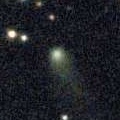
|
Now it is 17.3 mag (Mar. 10, Catalina Sky Survey). Fading slowly. In the Southern Hemisphere, it is not observable after this.
Date(TT) R.A. (2000) Decl. Delta r Elong. m1 Best Time(A, h)
Mar. 18 18 40.41 51 45.9 6.290 6.247 82 17.4 4:43 (225, 60)
Mar. 25 18 44.56 53 2.9 6.303 6.281 84 17.5 4:32 (221, 62)
|

|
Now it is 17.4 mag (Mar. 12, ATLAS-HKO, Haleakala). Fading slowly. In the Northern Hemisphere, it stays observable in good condition for a long time. In the Southern Hemisphere, it is not observable after this.
Date(TT) R.A. (2000) Decl. Delta r Elong. m1 Best Time(A, h)
Mar. 18 18 33.37 71 58.7 9.779 9.791 87 17.5 4:43 (195, 49)
Mar. 25 18 33.07 72 57.3 9.807 9.808 87 17.5 4:32 (192, 50)
|
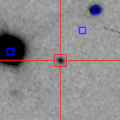
|
It will approach to Sun down to 0.4 a.u. in late September in 2024, and it is expected to brighten up to 0 mag. Now it is 17.2 mag (Mar. 7, ATLAS Chile). It stays observable in good condition for a while. At the high light, in the Northern Hemisphere, it will be observable in good condition after the perihelion passage. In the Southern Hemisphere, it will be observable in the low sky before and after the perihelion passage.
Date(TT) R.A. (2000) Decl. Delta r Elong. m1 Best Time(A, h)
Mar. 18 15 16.90 -0 15.3 6.453 7.107 127 17.6 3:37 ( 0, 55)
Mar. 25 15 14.05 0 7.7 6.305 7.045 134 17.5 3:07 ( 0, 55)
|
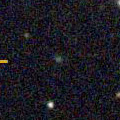
|
Now it is 17.4 mag (Feb. 16, Toshihiko Ikemura, Hirohisa Sato). It stays 17 mag for a long time from 2023 to 2024. It is observable in good condition in the Northern Hemisphere. In the Southern Hemisphere, it is not observable until July.
Date(TT) R.A. (2000) Decl. Delta r Elong. m1 Best Time(A, h)
Mar. 18 2 46.04 28 58.0 7.517 6.951 52 17.6 19:33 (104, 34)
Mar. 25 2 50.70 29 14.5 7.587 6.938 46 17.6 19:39 (108, 28)
|
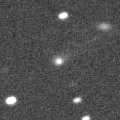
|
It brightened up to 15.9 mag in 2022 spring (May 5, Toshiyuki Takahashi). Now it is 17.5 mag (Mar. 11, ATLAS South Africa). In 2023, it is observable at 17.5 mag in spring.
Date(TT) R.A. (2000) Decl. Delta r Elong. m1 Best Time(A, h)
Mar. 18 16 30.55 -24 15.6 4.488 4.875 107 17.7 4:43 (358, 31)
Mar. 25 16 31.40 -24 23.8 4.393 4.881 113 17.7 4:24 ( 0, 31)
|
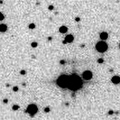
|
Now it is 17.7 mag (Feb. 26, A. Diepvens). It will be fading after this, and it will be fainter than 18 mag in April. It locates somewhat low in the Southern Hemisphere.
Date(TT) R.A. (2000) Decl. Delta r Elong. m1 Best Time(A, h)
Mar. 18 5 56.56 25 39.5 3.779 3.948 92 17.8 19:33 ( 66, 71)
Mar. 25 6 0.81 25 35.2 3.886 3.951 86 17.8 19:39 ( 75, 65)
|
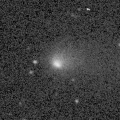
|
It brightened up to 14.6 mag in autumn (Oct. 19, Toshihiko Ikemura, Hirohisa Sato). Now it is fading. It has already faded down to 17.6 mag (Feb. 16, Toshihiko Ikemura, Hirohisa Sato). It will be fainter than 18 mag in spring.
Date(TT) R.A. (2000) Decl. Delta r Elong. m1 Best Time(A, h)
Mar. 18 3 34.54 13 54.7 2.760 2.388 58 17.8 19:33 ( 81, 37)
Mar. 25 3 47.21 14 45.9 2.853 2.411 54 17.9 19:39 ( 86, 33)
|
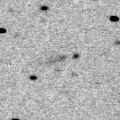
|
Now it is 18.2 mag (Feb. 27, Ken-ichi Kadota). It stays observable at 18 mag in good condition from January to March. It looks elongated.
Date(TT) R.A. (2000) Decl. Delta r Elong. m1 Best Time(A, h)
Mar. 18 10 10.16 15 54.2 3.280 4.184 151 17.8 22:27 ( 0, 71)
Mar. 25 10 7.89 16 9.6 3.332 4.182 144 17.8 21:58 ( 0, 71)
|

|
Now it is 18 mag (Feb. 11, Giuseppe Pappa). It stays 17.5 mag until spring. It is observable in good condition in the Northern Hemisphere. It is not observable in the Southern Hemisphere.
Date(TT) R.A. (2000) Decl. Delta r Elong. m1 Best Time(A, h)
Mar. 18 4 44.11 71 30.8 3.028 3.124 86 17.9 19:33 (163, 49)
Mar. 25 5 9.89 69 15.7 3.088 3.127 82 17.9 19:39 (160, 50)
|

|
Now it is 17.9 mag (Mar. 10, A. Diepvens). It will brighten up to 15 mag from 2024 to 2025. In 2023, it is observable at 18 mag in spring.
Date(TT) R.A. (2000) Decl. Delta r Elong. m1 Best Time(A, h)
Mar. 18 9 32.99 26 22.1 3.546 4.345 138 17.9 21:50 ( 0, 81)
Mar. 25 9 30.08 26 22.4 3.606 4.333 131 17.9 21:20 ( 0, 81)
|

|
It was predicted to brighten up to 16 mag in 2023. But actually, it is very faint as 18.6 mag (Mar. 2, Taras Prystavski). In the Southern Hemisphere, it stays observable in good condition for a long time. In the Northern Hemisphere, it will never be observable again.
Date(TT) R.A. (2000) Decl. Delta r Elong. m1 Best Time(A, h)
Mar. 18 18 55.68 -74 11.9 3.205 3.259 84 18.0 4:43 (349,-22)
Mar. 25 19 21.11 -74 38.5 3.162 3.266 87 18.0 4:32 (349,-23)
|
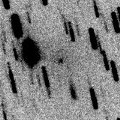
|
Tiny comet, but it approached to Sun down to 0.8 a.u. in January, and it will approach to Earth down to 0.6 a.u. in March. It was expected to brighten up to 14 mag from January to March. But actually, it became disintegrated before the perihelion passage. Now it is extremely faint as 18.2 mag (Feb. 20, Thomas Lehmann). In the Southern Hemisphere, it stays observable in good condition for a long time. It becomes observable in good condition after this also in the Northern Hemisphere.
Date(TT) R.A. (2000) Decl. Delta r Elong. m1 Best Time(A, h)
Mar. 18 6 39.42 -16 10.4 0.654 1.299 101 19.3 19:33 ( 11, 39)
Mar. 25 7 8.40 -3 23.4 0.759 1.389 103 19.8 19:39 ( 16, 51)
|
|
![]()
 C/2022 L2 ( ATLAS )
C/2022 L2 ( ATLAS ) C/2021 E3 ( ZTF )
C/2021 E3 ( ZTF ) 126P/IRAS
126P/IRAS 199P/Shoemaker 4
199P/Shoemaker 4 C/2022 W3 ( Leonard )
C/2022 W3 ( Leonard ) C/2022 A3 ( Lemmon-ATLAS )
C/2022 A3 ( Lemmon-ATLAS ) C/2018 U1 ( Lemmon )
C/2018 U1 ( Lemmon ) 94P/Russell 4
94P/Russell 4 P/2023 B1 ( PanSTARRS )
P/2023 B1 ( PanSTARRS ) 263P/Gibbs
263P/Gibbs C/2020 Y2 ( ATLAS )
C/2020 Y2 ( ATLAS ) C/2023 A1 ( Leonard )
C/2023 A1 ( Leonard ) C/2023 B2 ( ATLAS )
C/2023 B2 ( ATLAS ) 116P/Wild 4
116P/Wild 4 C/2019 E3 ( ATLAS )
C/2019 E3 ( ATLAS ) C/2023 E1 ( ATLAS )
C/2023 E1 ( ATLAS ) C/2020 F2 ( ATLAS )
C/2020 F2 ( ATLAS ) 280P/Larsen
280P/Larsen C/2022 U4 ( Bok )
C/2022 U4 ( Bok ) 204P/LINEAR-NEAT
204P/LINEAR-NEAT C/2022 Q2 ( ATLAS )
C/2022 Q2 ( ATLAS ) 408P/2020 M7 ( Novichonok-Gerke )
408P/2020 M7 ( Novichonok-Gerke ) P/2022 L3 ( ATLAS )
P/2022 L3 ( ATLAS ) 180P/NEAT
180P/NEAT P/2021 N2 ( Fuls )
P/2021 N2 ( Fuls ) C/2014 UN271 ( Bernardinelli-Bernstein )
C/2014 UN271 ( Bernardinelli-Bernstein ) 402P/2020 Q3 ( LINEAR )
402P/2020 Q3 ( LINEAR ) C/2020 H6 ( ATLAS )
C/2020 H6 ( ATLAS ) C/2019 O3 ( Palomar )
C/2019 O3 ( Palomar ) C/2023 A3 ( Tsuchinshan-ATLAS )
C/2023 A3 ( Tsuchinshan-ATLAS ) C/2021 S4 ( Tsuchinshan )
C/2021 S4 ( Tsuchinshan ) 99P/Kowal 1
99P/Kowal 1 244P/Scotti
244P/Scotti 61P/Shajn-Schaldach
61P/Shajn-Schaldach 452P/2022 B5 ( Sheppard-Jewitt )
452P/2022 B5 ( Sheppard-Jewitt ) C/2022 W2 ( ATLAS )
C/2022 W2 ( ATLAS ) 65P/Gunn
65P/Gunn C/2021 C5 ( PanSTARRS )
C/2021 C5 ( PanSTARRS ) C/2022 S3 ( PanSTARRS )
C/2022 S3 ( PanSTARRS )![]()
































































